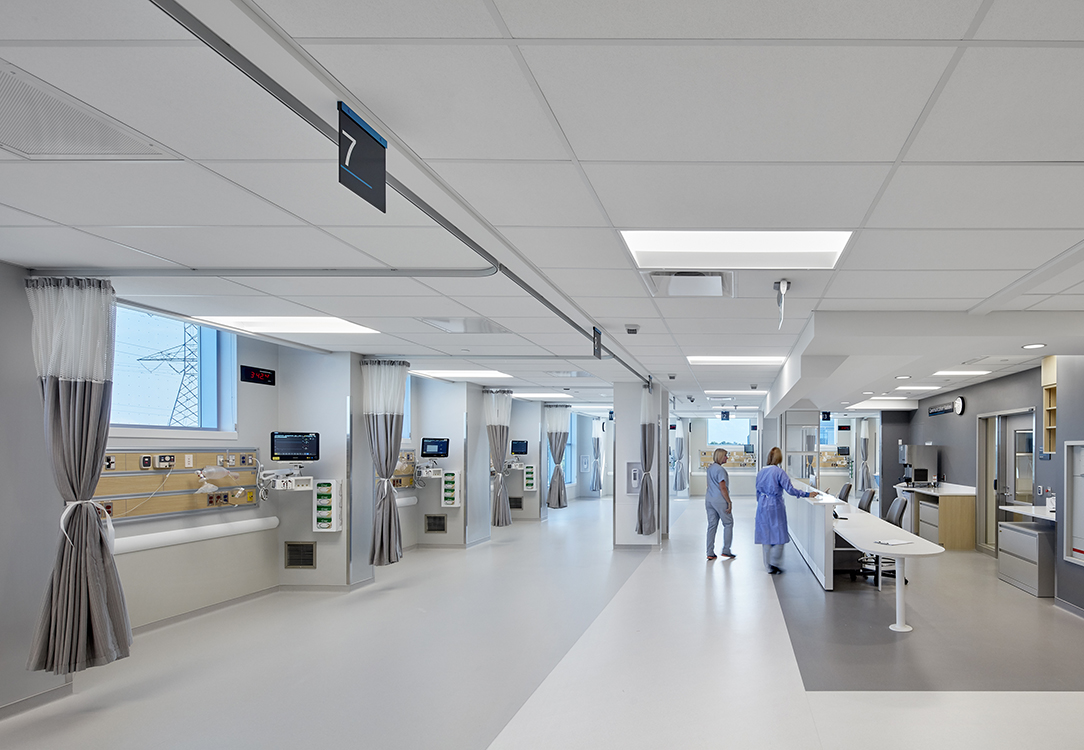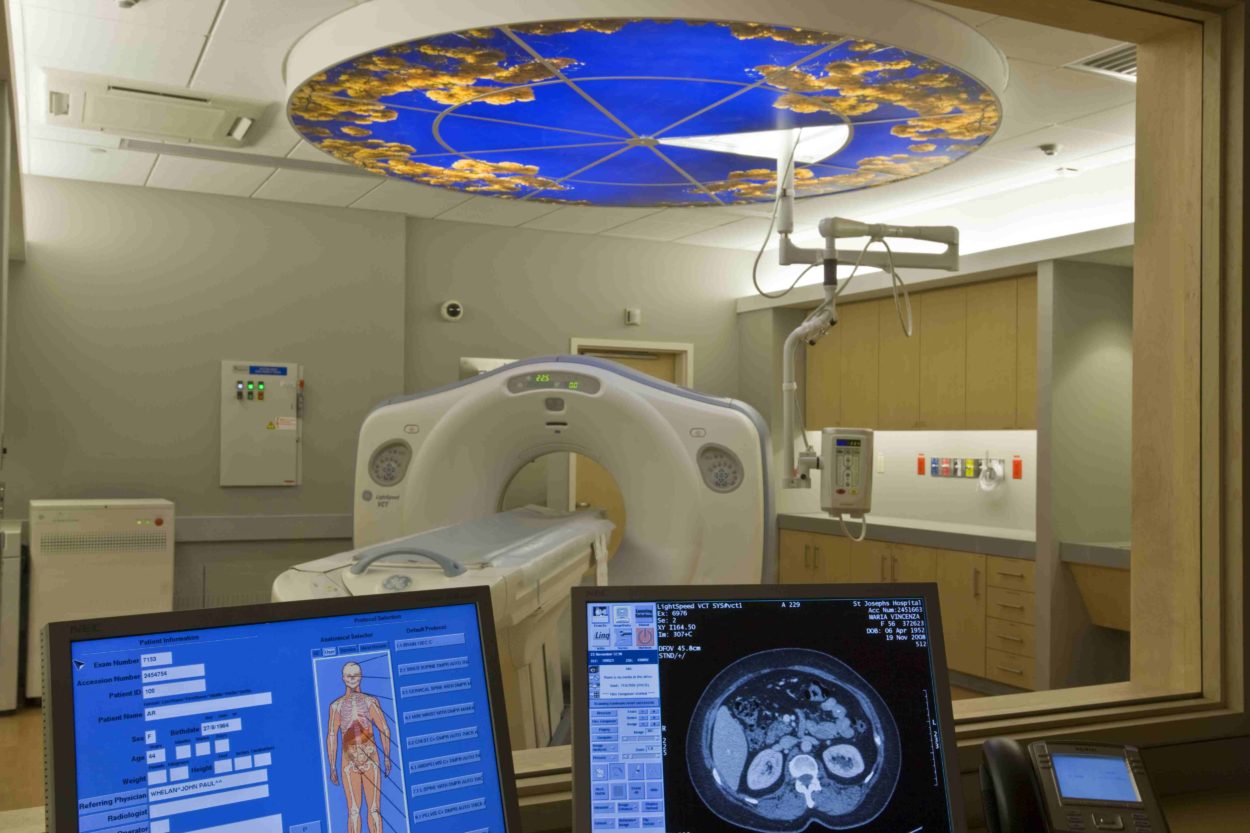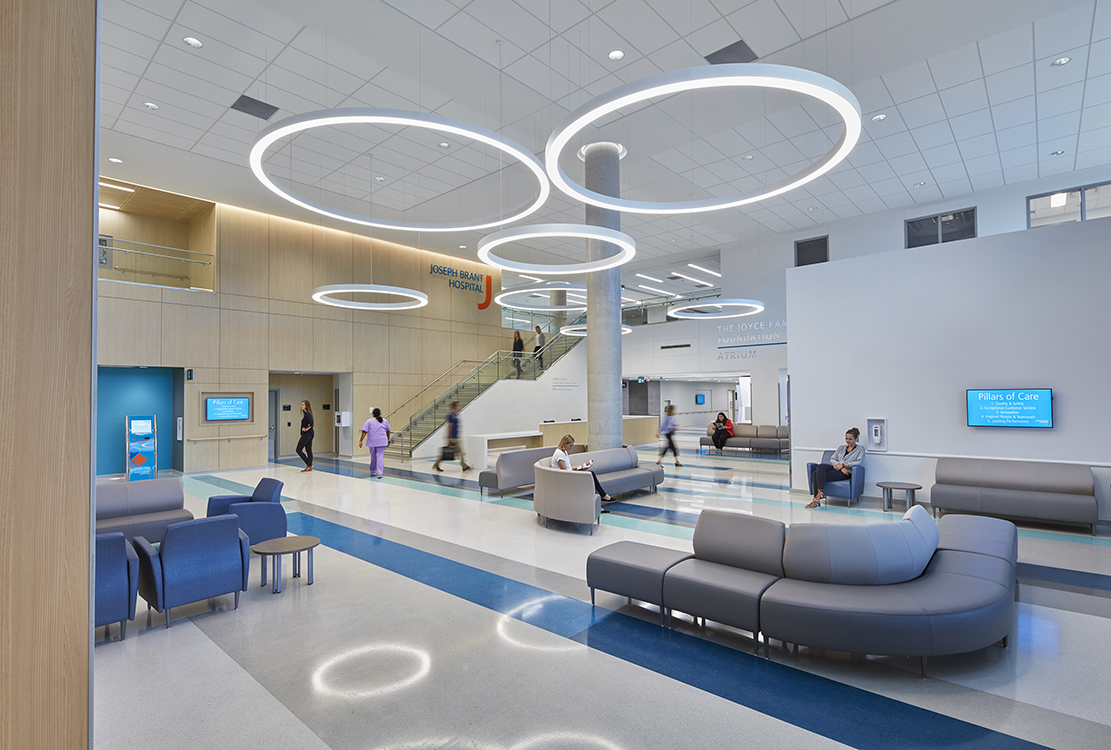



Hospital redevelopment projects provide a unique opportunity to build for the future
The increasingly critical role of technology in patient care has resulted in a dramatic increase in demands on communications and information technology infrastructure in hospitals, but aging facilities pose significant challenges to the staff who support and maintain these systems. Many hospitals in Canada were constructed well before the emergence of modern information technology, which typically means telecommunications equipment is squeezed into undersized spaces without sufficient power or cooling to ensure these important systems stay operational.
IT spaces added as an afterthought to existing construction In older buildings, telecommunications spaces have gradually expanded as the systems grow, creating a
number of challenges:
Limitations have a significant budget impact
All of these challenges can have a significant impact on operational and capital costs, and can add up to multiples of what is typical of a new installation with properly designed spaces and systems.
The greatest impact is seen in operational costs, where limitations make the systems more difficult to maintain, support and upgrade. From a user perspective, network performance can be affected by things such as heat or interference, which can create unnecessary delays in accessing information or even unplanned network downtime – a condition which critically impacts patient care across the entire facility. However, capital costs are not immune to these conditions either; overheating, dust and vibration can reduce the lifespan of equipment, meaning it must be replaced sooner.
Redevelopment with the future in mind
Hospital redevelopment provides the opportunity to build new IT systems that can withstand the test of time, and to address issues with existing systems in order to support expansion. While no one can predict the needs of technology decades from now, the following principles will help avoid creating similar challenges in the future:
It is also worth investigating which challenges can be addressed in place and which would benefit from a “greenfield” solution. For example, building a new data centre in a newly constructed area of the building is often less complex and cheaper than mitigating issues with the existing location. Many redevelopment projects use this opportunity to create a space that is properly sized and designed to support critical IT systems for the entire facility. The practicality of options should be evaluated as part of the planning process.
Ultimately, redevelopment projects are a chance for hospitals to create efficient and cost-effective IT systems capable of supporting the critical nature of technology in healthcare, and support the highest standard of patient care.
Author:

Kim Osborne Rodriguez,P.Eng., RCDD
kim.osbornerodriguez@hhangus.com
Published June 2016 in the Canadian Healthcare Engineering Society website

On January 13, Toronto’s Emerging Leader Forum (ELF) hosted an engaging discussion on Digital Health focused on informing young leaders in healthcare. The event was led by Dr. Darren Larsen, Chief Medical Information Officer at OntarioMD, who facilitated the discussion with:
Despite having a relatively straightforward label, the concept of digital health encompasses a complex set of ideas that differ greatly between sectors and people. While many associate digital health with smartphone apps and telehealth, Dr. Trevor Jamieson is quick to differentiate between virtual health and digital health, noting that “how you use data to drive better decision making” forms the core of how digital health impacts how we care for patients. Many would agree that data has become critical in the delivery of healthcare across varying sectors from acute to primary care, and the ability to manage and apply data efficiently will likely become future differentiators for providers in the healthcare market.
Unfortunately, one of the primary challenges of delivering on this definition of digital health is a lack of interoperability and integration both within and between healthcare organizations, which means that data cannot be leveraged to maximize its value. It’s not just enough to have astronomical amounts of data; it has to be delivered to the right person at the right time.
A combination of limited funding and a conservative approach to technology seem to be the biggest obstacles to the adoption of digital health in Ontario, but Laurie Poole is optimistic: “Technology used to be an afterthought, so there has been a big shift from even four years ago.”
However, funding models that reward physical presence rather than virtual care, and privacy legislation that limits how organizations store and share data are two big barriers noted by David Denov and Dr. Jamieson. “Hospitals and providers have convinced themselves that change has to be incremental, and that disruption is undesirable,” says Dr. Jamieson. “You will never have innovation without a bit of risk.” Clearly innovation needs to be balanced with the risk and potential consequences for patients and their data.
Looking to other health systems that have achieved widespread adoption of technology and digital health, it appears that that big changes have to be driven (or at least strongly supported) from the top down – and not just within the hospital, but from health systems or regional leadership in healthcare. Poole points out that integrated health systems in the US have leveraged their power as a closed system with a single HIS to drive mainstream adoption of virtual care, but that a lack of integration in Ontario has been a key challenge in achieving the same adoption. Many G8 countries are facing similar challenges of constricted spending, limited infrastructure and an aging population, and consolidating leadership at a regional or provincial level may help coordinate adoption. “Every [Ontario] hospital has an independent board of directors,” Dr. Jamieson adds, which may contribute to the challenges in achieving widespread adoption.
This might imply that Ontario hospitals are stuck in siloed information systems without a strong mandate from provincial leadership, but momentum is building and there are a number of initiatives which are working towards broader integration. Initiatives such as ConnectingGTA and the current [as of 2016] provincial hold on new Hospital Information System implementations may be the first step towards standardization.
From the patient perspective, there is a growing expectation of digital health integration throughout their healthcare journey regardless of care location. Many of our Ontario hospitals have been able to leverage digital health effectively within their own organizations and work with healthcare partners on a community level, but growing pressure from patients will likely continue to push for provincial and even national initiatives which improve on inter-organizational integration. It is certainly clear that digital health has the opportunity to transform how care is delivered to the patient – from improved data analytics & big data to driving better patient outcomes through 360-degree healthcare coordination, digital health is becoming an essential part of effective healthcare.
Author: Kim Osborne Rodriguez, P.Eng., RCDD

The information technology needs of health care institutions are rapidly expanding, which makes it critical that the communications infrastructure is planned strategically.
Authors: Kim Osborne Rodriguez, P.Eng., RCDD | Megan Angus, RN, MBA, Lean, EDAC
Published September 2015 in the Canadian Consulting Engineer Magazine
Download complete article - Future-Proofing Hospitals – September 2015 >

Real-Time Locating Systems
In 2012, Canada spent $60.6 billion on hospitals alone, up more than $10 billion from 2009. Although total healthcare spending (encompassing hospitals, drugs, physicians, administration and capital) has grown steadily in the last two decades, the percentage share of funding allocated to hospitals has steadily dropped in the last 40 years, from nearly half of total healthcare spending in 1975, to less than one-third in 2012. Hospitals have had to deliver the same services to more patients without significant increases in funding to match demand. As a result, there is a greater emphasis on efficiency alongside patient safety and satisfaction.
American hospitals are considered by many to be at the forefront of embracing cutting-edge technologies aimed at reducing costs and improving efficiency. Other countries often follow-suit once there are proven U.S. hospital business cases that substantiate the benefits.
A recent example of this is the widespread adoption of real-time locating systems (RTLS), which are used to track patients, staff and assets. RTLS typically uses Wi-Fi or proprietary technology, or a combination of both, to triangulate the location of radio-frequency tags within a building and then display the locations on a map. Tags are attached to people or items to be tracked. Authorized staff are able to easily search for the location of a specific tag or category of tags. RTLS is now being implemented in the majority of new build and redevelopment hospital projects in Canada.
Many of the financial benefits of RTLS come from the ability to track assets and equipment in a hospital. Other benefits include increased staff efficiency and satisfaction, improved maintenance, reduced capital replacement costs and evidence-based decision-making.
Increased Staff Efficiency and Satisfaction
Data from the Canadian Institute for Health Information suggests that worker compensation makes up more than 60 per cent of total hospital costs and the majority of this goes to nurses. Other studies have shown that nurses spend between seven and 20 per cent of their shift searching for equipment and supplies, taking time away from patient care and other responsibilities. Asset tracking significantly reduces “wasted” time locating items, which improves nursing efficiency. It also benefits patients since outcomes improve when nurses are able to spend more time at the bedside.
Improved Maintenance
The efficiency gains extend to biomedical and facilities staff as well. Preventive maintenance is not only important for maintaining warranties and extending the useful life of equipment, but also has a critical impact on patient safety by ensuring that medical equipment is functioning properly. Research by the World Health Organization indicates that globally, up to 60 per cent of hospital medical equipment is not maintained properly, potentially leading to premature failure or adverse patient outcomes. Given that significant time is often spent locating equipment for maintenance or recalls (with mixed success), asset tracking improves operational efficiency, capital replacement and clinical metrics by ensuring that support staff are able to easily find it.
Reduced Capital Replacement Costs
A study by the American national care network VHA, Inc. (formerly “Voluntary Hospitals of America”) found that, on average, U.S. hospitals spend $4,000 per bed per year replacing lost or stolen equipment and supplies, leading to a total capital cost of approximately $2 million per year for a typical 500-bed hospital. Furthermore, research suggests hospitals buy 20 to 50 per cent more equipment than required, and most equipment has only a 40 to 50 per cent utilization rate.
Asset tracking reduces the required fleet size by making equipment more available and increasing its utilization, a benefit which the Ottawa Hospital leveraged to reduce an upcoming infusion pump deployment by approximately one-third after implementing a RTLS on its 3 million-square-foot campus.
Evidence-Based Decision-Making
When it comes to making purchasing decisions, there is generally a lack of clear information related to hospital needs, which can lead to an inefficient use of capital funds.
Asset tracking provides the data required to assess equipment usage, maintenance and failure rates in order to drive evidence-based purchasing decisions. This eliminates unnecessary equipment purchases and improves the overall usefulness of the hospital’s assets.
Building a Business Case
The return on investment (ROI) for RTLS is typically based on three areas of cost savings: improved clinical efficiency (operational/labour savings); increased utilization/fleet reduction (capital equipment savings); and reduction in loss/theft (capital equipment savings).
There are a number of different methods used to estimate the ROI for a given area of cost savings.
For operational efficiencies, ROI can be estimated using time studies, which track the amount of time spent finding equipment and supplies. These time studies should target assets that are routinely needed or those that take a long time to find, such as stretchers, wheelchairs, infusion pumps and IV poles.
Savings in capital expenditure can be estimated using industry averages. When considering the savings associated with fleet reduction, equipment fleets can generally be reduced by up to one-third. Theft can be reduced up to 50 per cent, depending on the current theft rate in the healthcare organization.
ROI calculations should take into account both the operational and capital expenditure savings anticipated through the implementation of asset tracking by calculating a total annual savings and estimated payback period based on information available within the organization.
Maximizing the Investment Value
Although asset tracking is an effective tool for improving hospital efficiency, maximizing the investment value requires looking beyond immediate cost savings to understand how the solution fits with the overall strategy and goals of the healthcare organization. For example, automatically making the real-time information available (through asset tracking) to other hospital systems helps reduce manual data entry,
freeing up additional resources and improving the quality and availability of information. To identify and maximize these opportunities, design and implementation of the RTLS should include consultations with clinical, support and facilities staff. The Angus Connect group facilitates this process by providing clinical and technical input to the design and planning for a real-time locating system, and how its functionality fits with the overall organizational strategy.
Ultimately, asset tracking provides an opportunity for healthcare organizations to reduce costs and provide better quality care for patients by improving hospital efficiency. The outlook is still optimistic: There may be unprecedented financial pressure on hospitals but there is a parallel unprecedented opportunity in the availability and effectiveness of new technology.
Author: Kim Osborne Rodriguez, P.Eng., RCDD
Published July 2015 in the Canadian Healthcare Facilities Magazine